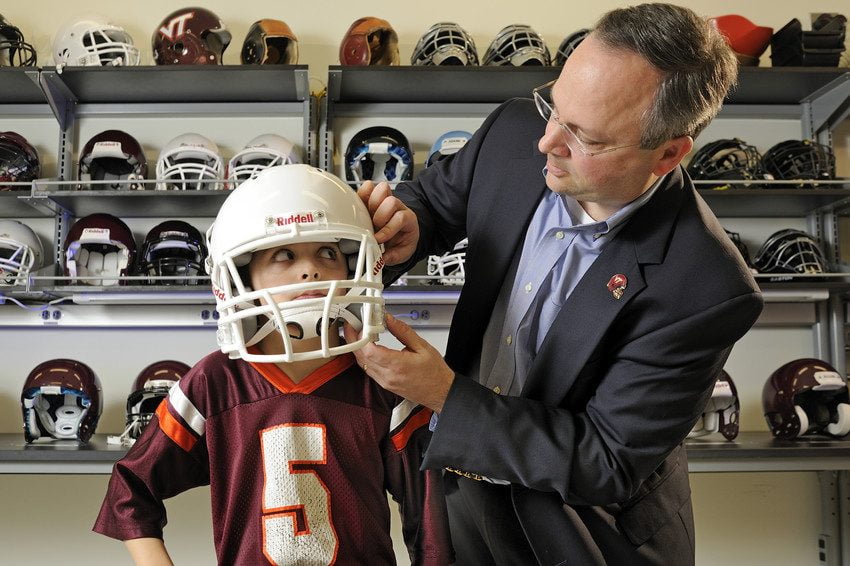
Stefan Duma founded the Virginia Tech Helmet Lab, where he and his team have revolutionized sports safety in part by putting football, hockey and other helmets through a battery of customized tests to measure how well they protect an athlete’s head during real-world impacts.
Stefan Duma, the Harry Wyatt Professor of Engineering, has been named director of the Virginia Tech Institute for Critical Technology and Applied Science.
Duma has served as interim director of the ICTAS for two years.
“ICTAS is critically important to our research enterprise and we are fortunate to have a talented leader in Stefan Duma,” said Julia M. Ross, the Paul and Dorothea Torgersen Dean of the College of Engineering. “He has a keen sense for the resources that will help faculty take their research to the next level, and he merges that with a leadership style that builds enthusiasm for the institute’s mission. It’s a powerful combination, and I look forward to further collaborating with him to support and build research at Virginia Tech.”
ICTAS, which recently celebrated its 10th anniversary, now encompasses three buildings on the Blacksburg campus, space in the National Capital Region, and growing collaborations in Roanoke
Helping drive research at the university, the institute supports interdisciplinary teams tackling potentially high-impact research, providing funding, shared workspaces, and other resources.
Faculty are often able to leverage ICTAS seed funds into larger sponsored research awards; the more than 200 faculty affiliated with the institute netted more than $81 million in research expenditures in the last fiscal year.
“Our investment institutes support faculty with seed funding and state-of-the-art instruments for their research,” said Theresa Mayer, Virginia Tech’s vice president for research and innovation. “Virginia Tech’s research portfolio continues to expand in both scale and impact. ICTAS is helping to drive that growth, and our researchers will benefit with Stefan at the helm.”
An accomplished researcher himself, Duma is a world-renowned expert on impact biomechanics. His work has transformed the study of head and eye injuries and driven the development of safer equipment and procedures in sports, the automotive and consumer-products industries, and the military.
He has authored 483 publications, including 144 journal papers and two books, and won more than $51 million in external funding from sources, including the NIH, NSF, DOD, DOT, FAA, and industry sponsors.
ICTAS-funded projects cover a wide swath of subject areas, but some of the institute’s most prominent initiatives include the Nanoscale Characterization and Fabrication Laboratory, which is a resource for faculty all over campus and now a node in the National Science Foundation’s national nanotechnology network, and the Virginia Tech Mid-Atlantic Aviation Partnership, which runs one of just seven Federal Aviation Administration-designated test sites for unmanned aircraft systems (and the new drone park overlooking Oak Lane).
The institute is actively engaged in the university’s Destination Areas and Strategic Growth Areas, and is working to promote diversity and inclusion through seed funding for new research collaborations.
“We have so many talented faculty and students at Virginia Tech, and it is an honor to play a role in advancing their work,” Duma said. “It’s exciting to watch these collaborations grow, from researchers from different fields who may not have worked together before to successful teams winning multimillion dollar grants.
These partnerships are foundation of research excellence at the university, and I am looking forward to working with them, and with Dean Ross and Vice President Mayer, to make sure they have the resources they need to thrive.”
Duma revolutionized the field of concussion biomechanics when he became the first researcher to install wireless acceleration sensors in football helmets in 2003, an innovation that allowed his team to measure hundreds of thousands of real-world head impacts, and track which ones resulted in injuries.
The data his techniques generated about head impact exposure in college, high school, middle school, and youth football led to national changes in rules and regulations; in youth football alone, those changes have prevented an estimated 150 million head-impacts per year.
Customized methods to recreate those impacts in the lab facilitated controlled, reproducible tests of safety equipment that players wear on the field.
The result was the Virginia Tech Helmet Ratings, which Duma released in 2011 in collaboration with Steve Rowson, an assistant professor of biomedical engineering and mechanics.
The five-star rating system was the first tool to offer consumers quantitative, evidence-based information about how well a particular helmet reduces concussion risk. It has spurred the design of safer headgear for football, as well as hockey, which was added to the ratings in 2014; the research team is expanding to other sports, including cycling and soccer.
Duma has also contributed to a broader understanding of gender differences in the biomechanics of sports-related concussions through landmark studies on head impacts in women’s soccer and women’s lacrosse. That work is part of a $30 million research partnership between the National Collegiate Athletic Association and the United States Department of Defense, for which Duma serves as Virginia Tech’s principal investigator.
Duma was recently named a Fellow of the Biomedical Engineering Society, the first faculty member at Virginia Tech to receive this honor.
He is also the editor-in-chief of the journal Annals of Biomedical Engineering, where he had served as an associate editor since 2009. By increasing the journal’s coverage of injury biomechanics, he boosted both the journal’s academic citation metrics and media coverage of its papers, enhancing public recognition of the field.
At Virginia Tech, Duma has also served as the head of the department of biomedical engineering and mechanics and of the Virginia Tech-Wake Forest School of Biomedical Engineering and Sciences. He was also the founding director of the university’s Center for Injury Biomechanics, now the world’s largest injury biomechanics group.
— Lindsey Haugh



